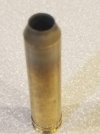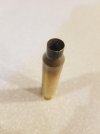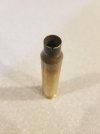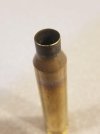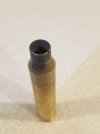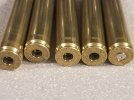I have always had excellent results with Peterson Brass, but after 4-5 firings on my .300 WM, I am starting to see necks
tear, sever, and become cracked.
I annealed this brass every firing.
The reason I switched to Peterson was case head separations above the belt in 3 firings, on the other brands.
I bump the shoulders back .002 every time, and have been careful not to over exercise the sizing die into causing fatique above the belts which is where I had problems before. Now, I have had no more case head separations and not even the tell tale circular cracking that comes just before it separates. Instead on about 5 of 50 of my Peterson cases, I am seeing cracks, and neck severing as in the pictures attached.
I am shooting the Peterson .300 WM belted regular brass, not the long brass. I am lubing the bullet bases with graphite powder prior to placing them in the necks to seat them. I have spoken to Muddyboots and he has recommended I lube the case necks inside before seating with case lube. I will try that next. I also have the Peterson .300 WM longs but have not tried them yet.
Now, the rifle I am loading for and firing these in is not a regular bolt gun, instead it is a bit of an odd duck, the TC Encore with switchable barrels. So it is a breach loader with some tendency to possible head spacing issues.
I'd be interested in hearing of any similar experience with neck cracking and failures on Peterson or other brass.
See the attached pictures. I took all of these out of my tumbler this last go round and then when I inspected them,
found these issues. I will definitely check my breech and bore on the rifle for the severed neck which is missing on the one casing.
Just in case......, no pun intended.
Yeah, that one that is severed and missing the neck looks like I left it in the trimmer waaaaaayyyyyy too long......
Until it was waaaaaayyyyyy too short!
tear, sever, and become cracked.
I annealed this brass every firing.
The reason I switched to Peterson was case head separations above the belt in 3 firings, on the other brands.
I bump the shoulders back .002 every time, and have been careful not to over exercise the sizing die into causing fatique above the belts which is where I had problems before. Now, I have had no more case head separations and not even the tell tale circular cracking that comes just before it separates. Instead on about 5 of 50 of my Peterson cases, I am seeing cracks, and neck severing as in the pictures attached.
I am shooting the Peterson .300 WM belted regular brass, not the long brass. I am lubing the bullet bases with graphite powder prior to placing them in the necks to seat them. I have spoken to Muddyboots and he has recommended I lube the case necks inside before seating with case lube. I will try that next. I also have the Peterson .300 WM longs but have not tried them yet.
Now, the rifle I am loading for and firing these in is not a regular bolt gun, instead it is a bit of an odd duck, the TC Encore with switchable barrels. So it is a breach loader with some tendency to possible head spacing issues.
I'd be interested in hearing of any similar experience with neck cracking and failures on Peterson or other brass.
See the attached pictures. I took all of these out of my tumbler this last go round and then when I inspected them,
found these issues. I will definitely check my breech and bore on the rifle for the severed neck which is missing on the one casing.
Just in case......, no pun intended.
Yeah, that one that is severed and missing the neck looks like I left it in the trimmer waaaaaayyyyyy too long......
Until it was waaaaaayyyyyy too short!

